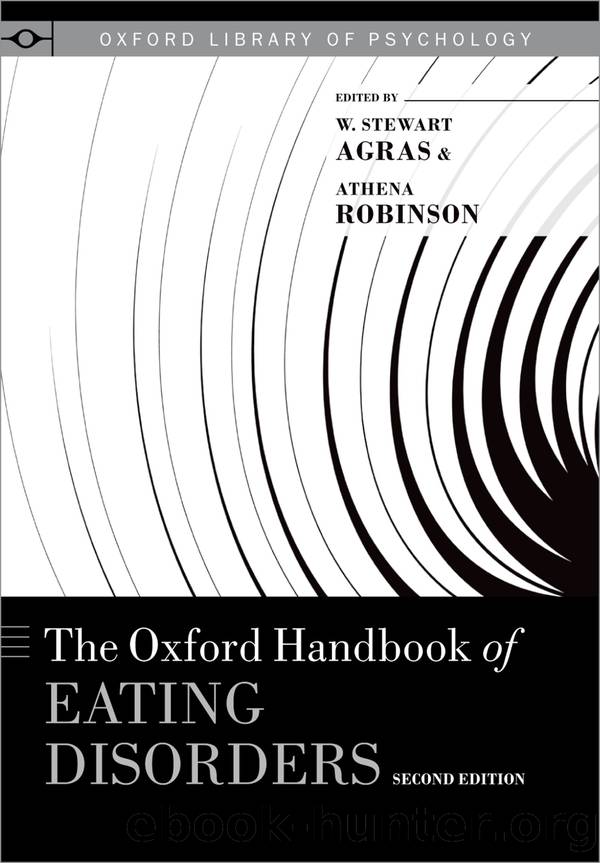The Oxford Handbook of Eating Disorders by W. Stewart Agras and Athena Robinson

Author:W. Stewart Agras and Athena Robinson
Language: eng
Format: epub
Publisher: Oxford University Press
Published: 2017-06-15T00:00:00+00:00
Generalizability of Treatment Effects from Controlled Research to Routine Clinical Care Settings
A long-standing criticism of randomized controlled trials (RCTs) of psychological treatments has been that they have tended to exclude patients with more multiple and more complex problems. The reason? The RCTs typically have focused on a single diagnostic category and participants in the study are recruited by the investigators. In response it has been well documented that more recent RCTs have included patients with severe psychopathology and high rates of psychiatric comorbidity. One of the most common reasons for screening out potential participants in RCTs is that the individual’s problems are not severe enough—do not meet strictly defined DSM-IV or DSM-5 criteria—to warrant inclusion. One of the strengths of the RCTs on BN summarized here is that deliberate efforts were made to include participants who were representative of patients typically treated in “real-world” clinical service settings. For example, the Fairburn et al. (2009) and Fairburn et al. (2015) trials of CBT-E used broad eligibility criteria so as not to be selective. Furthermore, study participants were recruited from a long-established community clinic in which the full range of eating disorder patients seeking help were treated. In order to determine the degree to which the RCT samples were broadly representative of the “real-world” population, a comparison was made of the participants recruited for the RCT with patients from the same geographical catchment area seen in the 12 months before and after the RCT (Wales, Palmer, & Fairburn, 2009). The results showed that the three different samples of patients were strikingly similar. It is clear that controlled treatment trials can be designed to be representative on routine care patient populations.
Three additional studies have investigated the outcome of CBT-E implemented in routine clinical care settings. In a public-outpatient eating disorders program for youth and adults in Perth, Australia, Byrne, Fursland, Allen, and Watson (2011) analyzed the treatment outcome of 125 patients including all eating disorders. Of the total sample those with a BN diagnosis numbered 40. At post-treatment 32.5% of the full sample (using an intent-to-treat analysis) were in full remission, namely, no eating disorder symptoms over the previous 28 days; 45% were in either full or partial remission. Of those who completed treatment, 50% were in full remission. Significant improvements were also evident on measures of depression, anxiety, stress, interpersonal problems, self-esteem, and quality of life. Overall the results were very similar to those reported in the original Fairburn et al. (2009) CBT-E trial in the UK. The single main difference between the two trials was the significantly higher dropout in the Australian sample—40% versus 22.1%.
A second study evaluated the results in 272 BN and eating disorder not otherwise specified (EDNOS) patients treated with CBT-E in a National Health Service eating disorders clinic in Wales (Knott, Woodward, Hoefkens, & Limbert, 2015). Of the total sample, 74 (27.2%) had BN. A positive treatment outcome defined in terms of global EDE-Q score of less than one standard deviation above the community mean was achieved by 78% of patients who completed treatment and 39.
Download
This site does not store any files on its server. We only index and link to content provided by other sites. Please contact the content providers to delete copyright contents if any and email us, we'll remove relevant links or contents immediately.
When Breath Becomes Air by Paul Kalanithi(7261)
Why We Sleep: Unlocking the Power of Sleep and Dreams by Matthew Walker(5639)
Paper Towns by Green John(4168)
The Immortal Life of Henrietta Lacks by Rebecca Skloot(3824)
The Sports Rules Book by Human Kinetics(3585)
Dynamic Alignment Through Imagery by Eric Franklin(3487)
ACSM's Complete Guide to Fitness & Health by ACSM(3466)
Kaplan MCAT Organic Chemistry Review: Created for MCAT 2015 (Kaplan Test Prep) by Kaplan(3422)
Introduction to Kinesiology by Shirl J. Hoffman(3299)
Livewired by David Eagleman(3121)
The River of Consciousness by Oliver Sacks(2992)
Alchemy and Alchemists by C. J. S. Thompson(2911)
The Death of the Heart by Elizabeth Bowen(2900)
Descartes' Error by Antonio Damasio(2731)
Bad Pharma by Ben Goldacre(2727)
Kaplan MCAT Behavioral Sciences Review: Created for MCAT 2015 (Kaplan Test Prep) by Kaplan(2491)
The Gene: An Intimate History by Siddhartha Mukherjee(2491)
The Fate of Rome: Climate, Disease, and the End of an Empire (The Princeton History of the Ancient World) by Kyle Harper(2434)
The Emperor of All Maladies: A Biography of Cancer by Siddhartha Mukherjee(2430)
